The 2015 MacBook Review
by Ryan Smith on April 14, 2015 10:15 AM ESTWindows Performance
Shifting gears from OS X, let’s take a look at performance under Windows. Though not every MacBook will be used with Windows, Windows gives us a wider selection of benchmarks to work with, and it gives us a chance to compare the MacBook to some contemporary PCs.
For our Windows comparison I’ve pulled in a number of results from our most recent Core M review, including other Core M laptops, the Haswell-U powered Surface Pro 3, and a couple of Broadwell-U powered laptops. Of particular interest is likely the Asus UX305, which is another Core M based laptop that uses a very similar build. At 13.3” it’s larger than the MacBook, but it is a similar aluminum fanless design.


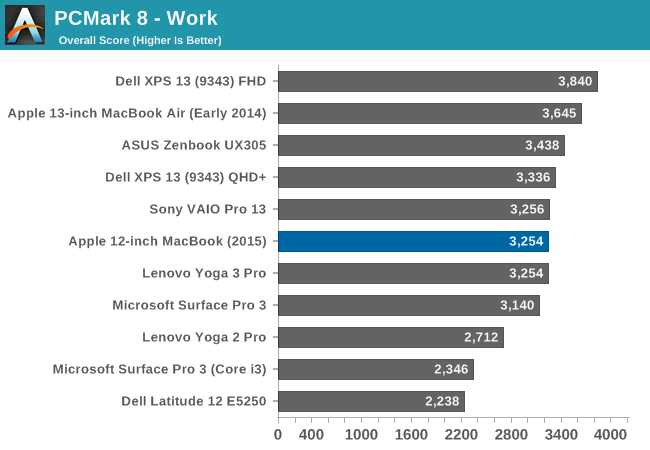
Depending on which sub-test we’re looking at, the PCMark workloads are a mix of bursty workloads, lightly threaded workloads, and heavily threaded workloads. As a result the MacBook and its Core M processor are given some opportunity to show off, and at other times is pushed back due to its cap on sustained performance.
The Home workload is one such light test, which plays into the MacBook’s favor. Here it’s towards the top of the charts, surpassing everything other than the Core M based Asus UX305, and then the more powerful Broadwell-U based Dell XPS 13s. I keep rattling on about workload types and this is a good example of why it matters, because in a light workload the MacBook is among the fastest of the ultra-portables, beating out many other Core M devices and also some Haswell based Ultrabooks. Put another way, in a light workload Core M can already deliver (and at times exceed) one-generation old Haswell Ultrabooks.
As for the Creative and Work workloads, the MacBook still places relatively well. Doing this well on the Creative workload was a bit of a surprise, since it’s the most demanding benchmark of the 3. I suspect we may be seeing a mix of dividends from the SSD and Core M’s GPU, Otherwise the lighter Work test actually has the MacBook farther behind the pack, with performance in-line with other Core M laptops, though not as exciting compared to the Ultrabooks.
Overall, between our OS X and Windows CPU benchmarks, what we’re finding is that the performance of the MacBook generally mirrors our expectations given what we know about its design and component selection. Given a light workload that allows the Core M CPU inside of the MacBook to turbo to its fastest speeds, it’s a very potent competitor in a small package, able to give all but the most recent Ultrabooks a run for their money. However heavier, sustained workloads drive a wider gap in between the two classes of devices, and in those cases the MacBook offers performance closer to Ultrabooks a 3-4 years old.
Shifting gears one more time, let’s take a look at GPU performance. GPU workloads present an interesting scenario for Core M, and by extension the MacBook. The underlying Intel HD Graphics 5300 GPU is a GT2 configuration, making it moderately powerful for an iGPU, however the power and thermal constrains on the MacBook means that the laptop doesn’t have the power required to run a GT2 GPU at full speed.
With the Broadwell CPU cores alone able to chew up 4.5W and then-some, a combined GPU+CPU workload will generally put the MacBook in a pinch. Consequently I don’t see the MacBook being used as any kind of gaming machine – the MacBook Air is undoubtedly a much stronger contender – but it’s useful to put this performance in context.
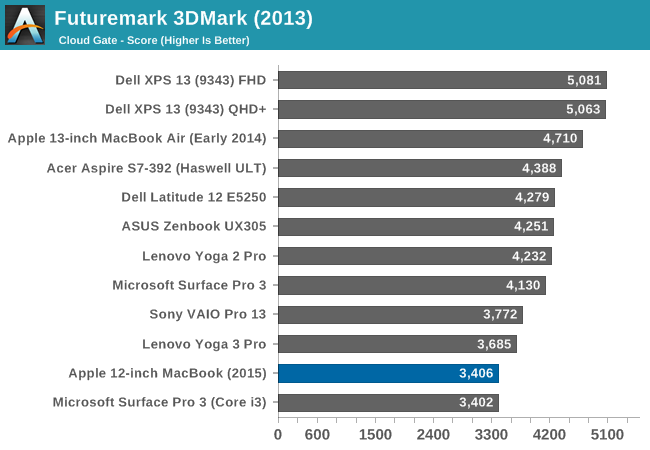
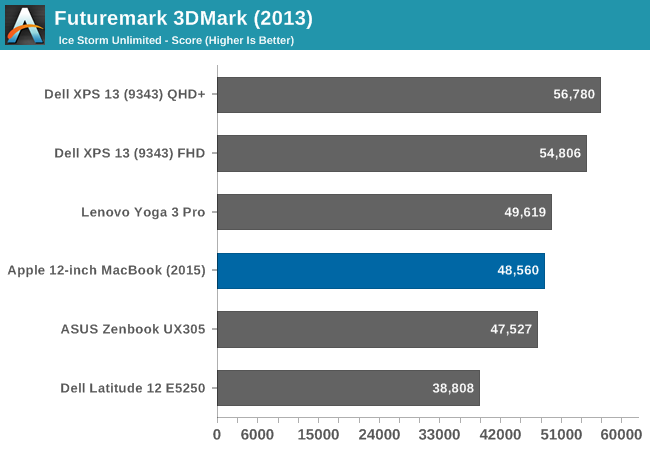
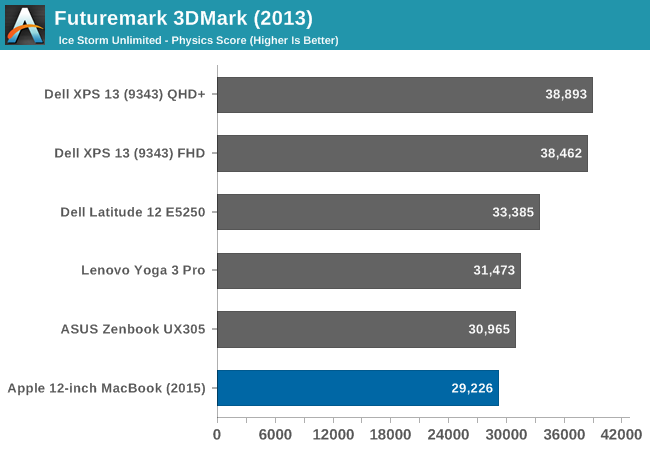
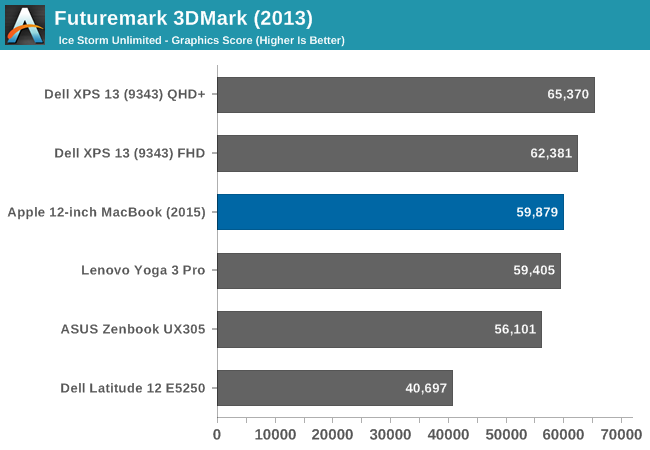
Our 3DMark scores handily illustrate this exact point. Facing significant power and thermal limits, the MacBook has to pull back in performance and consequently ends up near the bottom of our charts, versus its much better showing in PCMark. The 2014 MacBook Air 13” is some 38% faster at Cloud Gate, and on the newer Ice Storm benchmark the results aren’t much better. Of the two it’s worth noting that Cloud Gate is a much more complex and longer running benchmark, whereas Ice Storm is a quick running tablet-sized benchmark. Consequently Cloud Gate throttles harder and sooner, which is why the MacBook does relatively worse there. Overall the MacBook doesn’t even beat any of the other Core M laptops, which is a bit surprising. But nothing here is quite like the MacBook, so it’s somewhat different in its combination of small size and aluminum chassis.
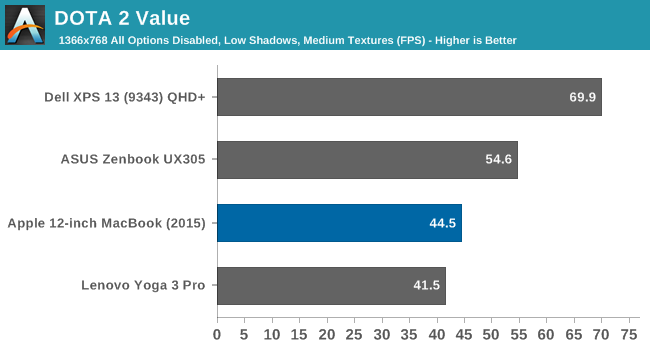
Meanwhile I have also run our DOTA 2 Value benchmark against our other Core M devices and the Broadwell-U based Dell XPS 13 for good measure. On an absolute basis 44.5fps is definitely playable for a game like DOTA, however on a relative basis this is a weaker showing than the UX305, not to mention the XPS 13. Compared to the UX305 the MacBook again appears to be throttling sooner and harder, whereas the Ultrabook-sized XPS takes full advantage of its higher power limits and better cooling.
Ultimately as we said when opening up our look at GPU performance, the MacBook’s GPU is potent on paper, but it simply doesn’t have the power and cooling capabilities needed to take full advantage of it. This means that while CPU performance isn’t too far removed from the Ultrabooks, GPU performance absolutely is.
Finally, I wanted to take one last look at performance relative to the tablets, this time from a GPU perspective.
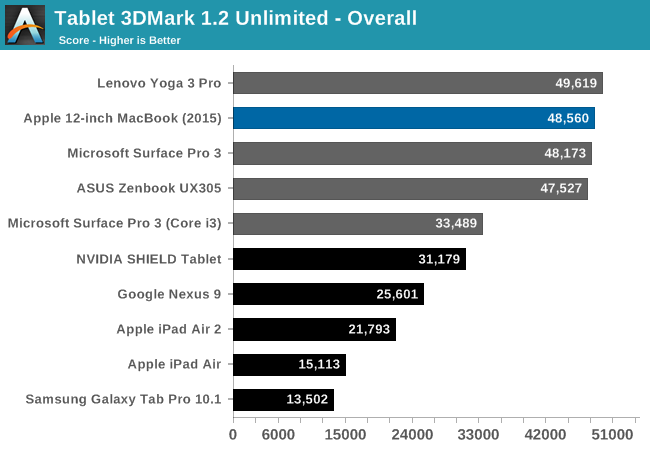
While the iPad Air 2 makes a good run on the MacBook in the web benchmarks, it and the other tablets are even more power limited than the MacBook, and as a result their GPU performance is even more constrained. The MacBook still has a better than 2x lead on the iPad Air 2 in this GPU benchmark, so judging from this it will be some time yet until an iPad's GPU performance catches up with this MacBook's.










354 Comments
View All Comments
sweenish - Tuesday, April 14, 2015 - link
Netbooks were a bit too miserable at the time. I wouldn't say this is the definitive line blurring device. I'd give that to the SP3.But this device is thin. Apple always impresses me with their hardware.
Impulses - Tuesday, April 14, 2015 - link
Netbooks weren't *that* bad at launch, relatively speaking, Atom was a lot better than the first gen VIA/etc stuff on the earliest netbooks... Problem is Intel sandbagged Atom and it stood still for years, took a few years until they even put out a mobo chipset that wasn't a total power hog and more appropriately matched Atom. OG Atom didn't launch in the Core i3/5 era, it just had to live on well into it before Intel woke up.Krysto - Tuesday, April 14, 2015 - link
$1300 netbooks FTW!mike55 - Tuesday, April 14, 2015 - link
Still not as expensive as this one: http://imgur.com/H1AhaY9TVC2 - Tuesday, April 14, 2015 - link
One thing that qualifies it as a "cross-over" is the 16x10 screen. Taller screens are part of the secret sauce that makes pads so useful; fear of letterbox (which is really bonus screen area) makes small laptops less useful without making them any easier to carry. Netbooks were just for surfing and checking mail. Jobs refused to build one - the iPad came out and netbooks went away.orthorim - Wednesday, April 15, 2015 - link
It's neither a Netbook nor a crossover. But a crossover would imply that it's in some way similar to a tablet, which it is not. This one comes with OS X, has a keyboard, and a USB port - it's not an appliance, it's a computer.I am thinking about it as a replacement for my retina MacBook Pro 15" but I think the screen is probably too small. Performance-wise I think it should be OK for programming - even if Xcode will doubtlessly bring it to its knees, as it seems to be able to do with any computer.
As for a pro computer needing massive CPU horsepower - that's a myth. Most of your daily tasks are going to be constrained by solid storage speed or internet speed, not by CPU speed.
Unless you're gaming (hardly a "pro" activity I may add), or encoding videos or rendering 3D, you don't need a quad core i7.
Things that have maxed out my CPU lately:
- Bad Apple software. Photos doing its face detection on my entire library for what seemed like an eternity
- Bad other software. Popcorn Time thanks to using a framework for video that seems even less efficient than Flash on the Mac, which is an achievement of sorts.
- Re-encoding Video. I do this so infrequently that I can probably live with it taking way longer.
eanazag - Wednesday, April 15, 2015 - link
I am totally happy to see Apple go with a 16 x 10 screen. I'd like all manufacturers to go this route.vampyren - Thursday, April 16, 2015 - link
hehe exactly :Dmrloadingscreen - Monday, April 20, 2015 - link
I don't know how you do it in the back there, but we don't call them lilmoes we call them "douche bags."blackmagnum - Tuesday, April 14, 2015 - link
"It was foretold by our forebears (circa 2013) that within this decade, the MacBook and the iPad would mate and produce an offspring."